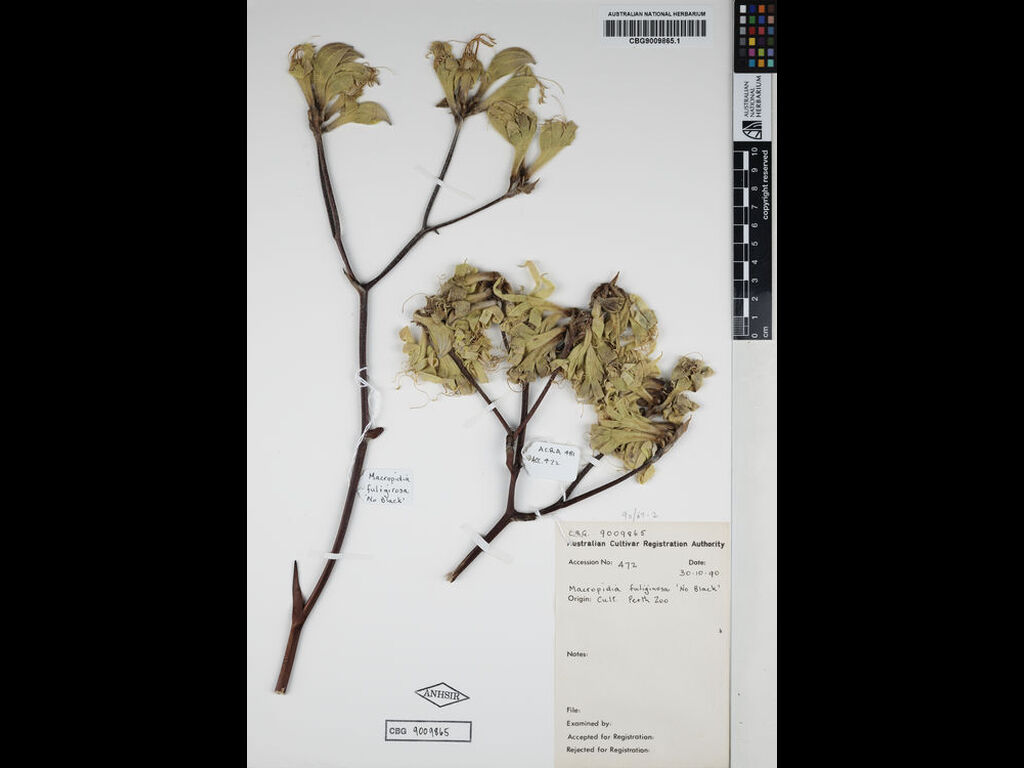Macropidia fuliginosa 'No Black'
- File Number
- 472
- ACRA Field Book Number
- 481
- Registration Date
- 11/10/1991
- Application Received
- 30/10/1990
- Family
- Haemodoraceae
- Cultivar Name
- Macropidia fuliginosa 'No Black'
- Origin
- A chance seedling raised in Aril 1989, from seed colleted from normal forms of Macropidia fuliginosa growing at Perth Zoo, South Perth, Western Australia..
- Characteristics
- The growth and habit of this cultivar are well within the usual range of growth forms of Macropidia. Flowering stems of container grown plants are 100cm high and divaricately branched. Flowers are 45-55mm long including stamens and up to 40mm wide when the perianth lobes reflex. The stellate hairs on the perianth are mostly yellow green mixed with grey orange, towards the ovary they increase in number where they become dense overlying almost black hairs. The grey orange hairs fade with age to white especially towards the perianth lobes. Sparse grey hairs are found on the upper scape. Inside the perianth the lower 2 lobes in particular, at the point where they reflex have a tinge of black amongst the glabrous shiny dark green colouring. The black is not evident on the normal forms of Macropidia growing at Perth Zoo. Whilst the reflexed perianth lobes curl back as the flowers age they appear to curl back faster in this cultivar initially at a 90 degrees angle giving the appearance of an open petaloid flower with only a short portion of the ends of the lobes curling inwards. Diagnosis: Habit and form similar to the usual forms of Macropidia. Its main distinguishing features are the unusual flower colour, predominantly yellow/green and the open petaloid-like appearance of the maturing flowers.
- Cultivation
- Due to its short period in cultivation its drought tolerance and frost resistance are unknown, however, it is expected to respond the same as usual forms of Macropidia. Propagation must be by vegetative means to preserve the exact form.
- Publication
- RHS Cultivar Registration Bulletin 2 (2022), p38;
- Colour Coding
- RHS Colour Chart 1966Perianth: underlying colour green group 142B to C.Perianth hairs: overall colour yellow green group 154C, mixed withgreyed orange group 164D to overlying black group 202A to 202B onovary.Upper scape hairs: sparse greyed-orange group 220B
- Propagation
- Division or tissue culture
- Applicant Name
- J Hickman, Perth Zoo, PO Box 489, SouthPerth, WA 6151.
- Uses
- As part of a mass planting or mixed in a shrubbery, or as a spectacular feature plant.
- Availability
- Unknown
- ANBG Accession Numbers
- ACC472, ACRA481, CBG9009865
- NSL ID
- -
